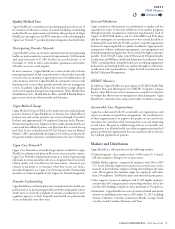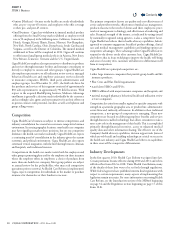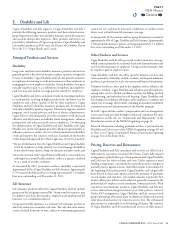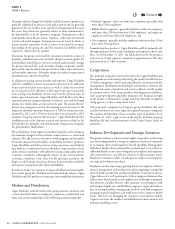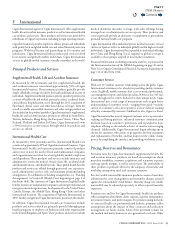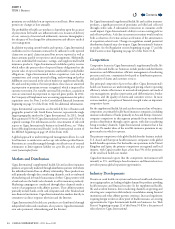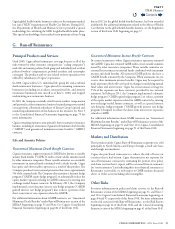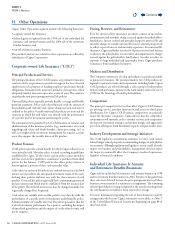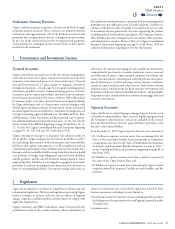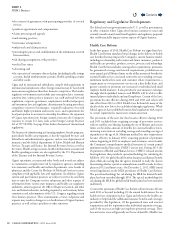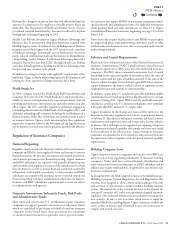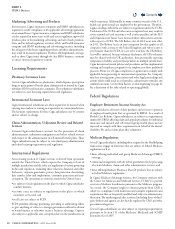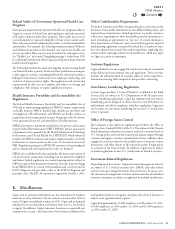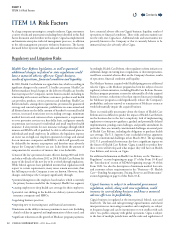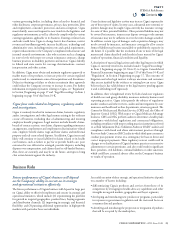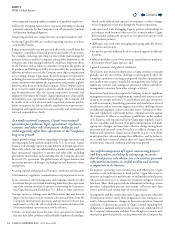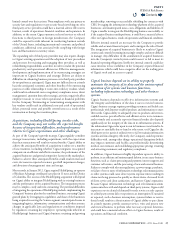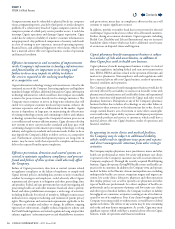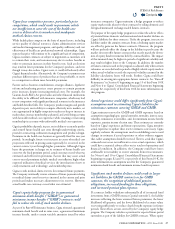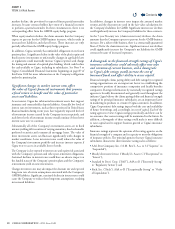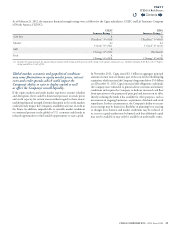Cigna 2011 Annual Report Download - page 41
Download and view the complete annual report
Please find page 41 of the 2011 Cigna annual report below. You can navigate through the pages in the report by either clicking on the pages listed below, or by using the keyword search tool below to find specific information within the annual report.
19CIGNA CORPORATION2011 Form10K
PARTI
ITEM 1 Business
Reform also changed certain tax laws that will eectively limit the
amount of compensation for employees of health insurers that is tax
deductible. e Department of Health and Human Services has not
yet dened “essential health benets” that must be oered by all plans
through state exchanges beginning in 2014.
Health Care Reform also impacts Cigna’s Medicare Advantage and
Medicare PartD prescription drug plan businesses acquired with
HealthSpring in a variety of additional ways, including reduced Medicare
premium rates (which began with the 2011 contract year), transition
of Medicare Advantage “benchmark” rates to Medicare fee-for-service
parity, reduced enrollment periods and limitations on disenrollment,
and providing “quality bonuses” for Medicare Advantage plans with a
rating for four or ve stars from CMS. rough Health Care Reform
and other federal legislation, funding for Medicare Advantage plans
has been and may continue to be altered.
In addition to acting to comply with applicable requirements of the
legislation, Cigna is closely monitoring regulatory developments and
keeping its clients apprised of changes that may aect them.
Dodd-Frank Act
In 2010, Congress enacted the Dodd-Frank Wall-Street Reform and
Consumer Protection Act (the “Dodd-Frank Act”) which provides for a
number of reforms and regulations in the corporate governance, nancial
reporting and disclosure, investments, tax and enforcement areas that
aect Cigna. e SEC and other regulatory authorities engaged in
rulemaking eorts under the Dodd-Frank Act throughout 2011, and
additional rulemaking still continues, including the establishment of a
Federal Insurance Oce that will develop and coordinate federal policy
on insurance matters. Cigna is closely monitoring how these regulations
impact the Company, however the full impact of the legislation may
not be known for several years until regulations become fully eective.
Regulation of Insurance Companies
Financial Reporting
Regulators closely monitor the nancial condition of licensed insurance
companies and HMOs. States regulate the form and content of statutory
nancial statements, the type and concentration of permitted investments,
and corporate governance over nancial reporting. Cigna’s insurance
and HMO subsidiaries are required to le periodic nancial reports
and schedules with regulators in most of the jurisdictions in which
they do business as well as annual nancial statements audited by
independent certied public accountants. Certain insurance and HMO
subsidiaries are required to le an annual report of internal control over
nancial reporting with most jurisdictions in which they do business.
Insurance and HMO subsidiaries’ operations and accounts are subject
to examination by such agencies.
Guaranty Associations, Indemnity Funds, Risk Pools
and Administrative Funds
Most states and certain non-U.S. jurisdictions require insurance
companies to support guaranty associations or indemnity funds,
which are established to pay claims on behalf of insolvent insurance
companies. In the UnitedStates, these associations levy assessments
on member insurers licensed in a particular state to pay such claims.
Several states also require HMOs to participate in guaranty funds,
special risk pools and administrative funds. For additional information
about guaranty fund and other assessments, see Note23 to Cigna’s
Consolidated Financial Statements beginning on page119 of this
Form10-K.
Some states also require health insurers and HMOs to participate
in assigned risk plans, joint underwriting authorities, pools or other
residual market mechanisms to cover risks not acceptable under normal
underwriting standards.
Solvency and Capital Requirements
Many states have adopted some form of the National Association of
Insurance Commissioners (“NAIC”) model solvency-related laws and
risk-based capital rules (“RBC rules”) for life and health insurance
companies. e RBC rules recommend a minimum level of capital
depending on the types and quality of investments held, the types of
business written and the types of liabilities incurred. If the ratio of the
insurer’s adjusted surplus to its risk-based capital falls below statutory
required minimums, the insurer could be subject to regulatory actions
ranging from increased scrutiny to conservatorship.
In addition, various non-U.S. jurisdictions prescribe minimum surplus
requirements that are based upon solvency, liquidity and reserve coverage
measures. During 2011, Cigna’s HMOs and life and health insurance
subsidiaries, as well as non-U.S. insurance subsidiaries, were compliant
with applicable RBC and non-U.S. surplus rules.
Cigna’s businesses in the European Union will be subject to the
directive on insurance regulation and solvency requirements known
as Solvency II. is directive will impose economic risk-based solvency
requirements and supervisory rules and is expected to become eective
in January2014, although certain regulators are requiring companies
to demonstrate technical capability and comply with increased capital
levels in advance of the eective date. Cigna’s European insurance
companies are capitalized at levels consistent with projected Solvency
II requirements and in compliance with anticipated technical capability
requirements.
Holding Company Laws
Cigna’s domestic insurance companies and certain of its HMOs are
subject to state laws regulating subsidiaries of insurance holding
companies. Under such laws, certain dividends, distributions and
other transactions between an insurance or HMO subsidiary and its
aliates may require notication to, or approval by, one or more state
insurance commissioners.
In December2010, the NAIC adopted revisions to the Model Insurance
Holding Company System Regulatory Act and Regulation. e
revisions were designed to allow a better understanding of the risks
and activities of non-insurance entities within a holding company
system.e main focus of the revisions has been to incorporate the
concept of “enterprise risk” and to enact provisions designed to provide
regulators with additional information and authority to manage this
new concept. To date, a few states have taken action to adopt the
amended Model Act and Regulation. Cigna continues to follow the
states’ activity in this area and will amend its processes as necessary to
comply with revised state laws.
Contents
Q


